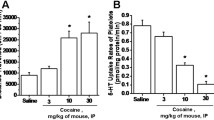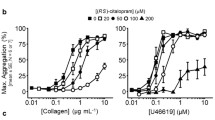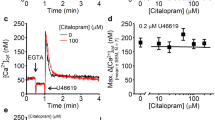Summary
Chronic treatment with phenothiazines and thioxanthenes has been found to enhance 5-HT-induced aggregation of human platelets. A method has been developed to study 5-HT2 receptor binding sites on platelets utilising [3H]-LSD and more recently125I/LSD. Results are presented which suggest that the LSD binding site is indeed the 5-HT2 binding site and that the LSD binding characterises the specific receptor responsible for 5-HT-induced shape change and aggregation.
In a group of patients receiving phenothiazines or thioxanthenes, theB max of LSD binding was increased. The mean binding affinity was decreased possibly due to a persistence of neuroleptic in the platelet membrane preparation. Analysis showed that this was not the reason why the mean binding capacity was increased.
The results show that chronic phenothiazine and thioxanthene δ treatment ‘up-regulates’ platelet 5-HT2 binding sites and that this may be accompanied by increased sensitivity to platelet aggregation by 5-HT.
In normal subjects desipramine treatment increased theB max of platelet LSD binding and this was accompanied by an increased prolactin response to tryptophan which is thought to be mediated by central 5-HT function.
Similar content being viewed by others
References
Anderson, I. M., and Cowen, P. J., Clomipramine enhances prolactin and growth hormone responses tol-tryptophan. Psychopharmacology89 (1986) 131–133.
Bennet, J. P., and Snyder, S. H., Stereospecific binding ofd-lysergic acid diethylamide (LSD) to brain membranes: relationship to serotonin receptors. Brain Res.94 (1975) 523.
Baldacci, M., Bergel, T. D., Born, G. V. R., and Hickman, M., Increases in aggregation by uptake of 5-hydroxytryptamine with platelets from rabbits treated with chlorpromazine. Br. J. Pharmac. Chemother.69 (1980) 113–118.
Boullin, D. J., Grahame-Smith, D. G., Grimes, R. P. J., and Woods, H. F., Inhibition of hydroxytryptamine induced human blood platelet aggregation by chlorpromazine and its metabolites. Br. J. Pharmac. Chemother.53 (1975) 121–125.
Boullin, D. J., Woods, H. F., Grimes, R. P. J., Grahame-Smith, D. G., Wiles, D., Gelder, M. G., and Kolakowska, T., Increased platelet aggregation responses to 5-hydroxytryptamine in patients taking chlorpromazine. Br. J. clin. Pharmac.2 (1975) 29–35.
Boullin, D. J., Orr, M. W., and Peters, J. R., The platelet as a model for investigating clinical efficacy of centrally acting drugs: relations between platelet aggregation and clinical condition in schizophrenics treated with chlorpromazine, in: Platelets: a Multi-disciplinary Approach. Eds S. E. de Gaetano and S. Gorathine. Raven Press, New York 1978.
Boullin, D. J., Knox, J. M., Peters, J., and Orr, M., Platelet aggregation and chlorpromazine therapy. Br. J. clin. Pharmac.6 (1978) 538–540.
Cowen, P. J., and Anderson, I. M., in: Recent advances in the biology of depression. Eds. J. F. W. Deakin and H. Freeman. Royal College of Psychiatrists, special publication, 1986.
Cowen, P. J., Geaney, D. P., Schacter, M., Green, A. R., and Elliott, M. J., Desipramine treatment in normal subjects effects on neuroendocrine response to tryptophan and on platelet serotonin (5-HT)-related receptors. Archs gen. Psychiat.43 (1986) 61–67.
Cross, A. J., Interactions of [3H]-LSD with serotonin receptors in human brain. Eur. J. Pharmac.82 (1982) 77.
Dawbarn, D., Long, S. K., and Pycock, C. J., Increased central 5-hydroxytryptamine receptor mechanisms in rats after chronic neuroleptic treatment. Br. J. Pharmac. Chemother.73 (1981) 149–156.
Geaney, D. P., Schacter, M., Elliott, J. M., and Grahame-Smith, D. G., Characterization of [3H]-Lysergic acid diethylamide binding to a 5-hydroxytryptamine receptor on human platelet membranes. Eur. J. Pharmac.97 (1984) 87–93.
Glue, P. W., Cowen, P. J., Nutt, D. J., Kolakowska, T., and Grahame-Smith, D. G., The effect of Lithium on 5-HT mediated neuroendocrine responses and platelet 5-HT receptors. Psychopharmacology90 (1986) 398–402.
Hefez, A., Oppenheim, B., and Youdim, M. B. H., Human platelet aggregation response to serotonin as an index of efficacy of chlorpromazine, in: Enzymes and Neurotransmitters in Mental Disease, pp. 77–93. Eds E. Usdin, T. L. Sourkes and M. B. H. Youdim. John Wiley, New York 1980.
Knox, J. M., Orr, M. W., Allen, R., Gelder, M. G., and Grahame-Smith, D. G., The reliability of 5-hydroxytryptamine reduced platelet aggregation responses in schizophrenic patients with neuroleptic drugs. Br. J. clin. Pharmac.11 (1981) 261–263.
Laubscher, A., and Pletscher, A., Shape change and uptake of 5-hydroxytryptamine in human blood platelets: actions of neuropsychotropic drugs. Life Sci.24 (1979) 1833.
Laubscher, A., Pletscher, A., and Noll, H., Interaction ofd-LSD with blood platelets of rabbits: shape, change and specific binding. J. Pharmac. exp. Ther.216 (1981) 385.
Leysen, J. E., Commeren, W., and de Clerck, F., Demonstration of S2-receptor binding sites in cat platelets using [3H]-ketanserin. Eur. J. Pharmac.88 (1983) 125–130.
Mills, D. C. B., and Roberts, G. C. K., Membrane active drugs and the aggregation of human blood platelets. Nature213 (1967) 35–38.
Orr, M. W., and Boullin, D. J., The relationship between changes in 5-HT induced platelet aggregation and the clinical state in patients treated with fluphenazine. Br. J. clin. Pharmac.3 (1976) 925–928.
Orr, M. W., Knox, J. M., Allen, R., Gelder, M. G., and Grahame-Smith, D. G., The effects of neuroleptic drugs on 5-hydroxytryptamine induced platelet aggregation in schizophrenic patients. Br. J. clin. Pharmac.11 (1981) 255–259.
Peroutka, S. J., and Snyder, S. H., Multiple serotonin receptors differential binding of [3H]-5-hydroxytryptamine, [3H]-lysergic acid diethylamide and [3H]-spiroperidol. Molec. Pharmac.16 (1979) 687–698.
Peroutka, S. J., and Snyder, S. H., Long-term antidepressant treatment decreases spiroperidol-labelled serotonin receptor treatment. Science210 (1980) 88–90.
Peters, J. R., and Grahame-Smith, D. G., Human platelet 5-HT receptors: characterisation and functional association. Eur. J. Pharmac.68 (1980) 243.
Schacter, M., Geaney, D. P., Grahame-Smith, D. G., Cowen, P., and Elliott, J. M., Increased platelet membrane [3H]-LSD binding in patients on chronic neuroleptic treatment. Br. J. clin. Pharmac.19 (1985) 453–457.
Author information
Authors and Affiliations
Rights and permissions
About this article
Cite this article
Grahame-Smith, D.G., Geaney, D.P., Schachter, M. et al. Human platelet 5-hydroxytryptamine receptors: Binding of [3H]-lysergic acid diethylamide (LSD). Effects of chronic neuroleptic and antidepressant drug administration. Experientia 44, 142–145 (1988). https://doi.org/10.1007/BF01952198
Published:
Issue Date:
DOI: https://doi.org/10.1007/BF01952198




